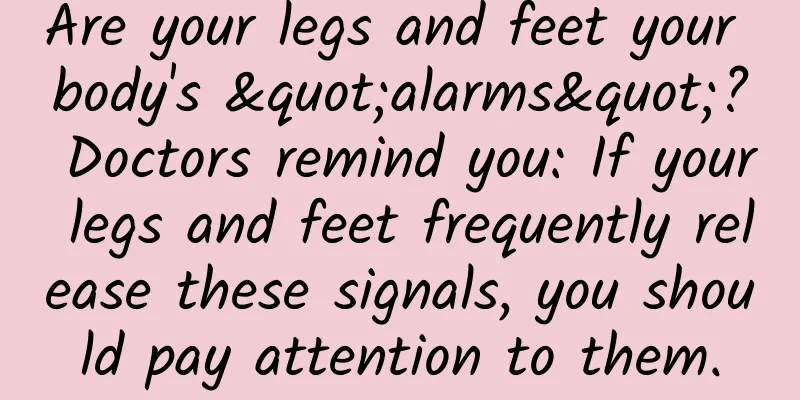Are your legs and feet your body's "alarms"? Doctors remind you: If your legs and feet frequently release these signals, you should pay attention to them.

|
The key to good health lies in the legs and feet. "Flexible legs and feet" is considered a sign of health. As people age, it is inevitable that their legs and feet will experience some pain, itching and other discomfort. Some symptoms may be signals of excessive blood sugar, cardiovascular and cerebrovascular diseases, and nerve damage. Legs and feet are the body's "alarms". Be careful if you see these symptoms Excessive blood sugar and cardiovascular and cerebrovascular diseases can also leave signals in the legs and feet: Health Times 1. Legs and feet are the human body's "blood sugar meter". In 2024, Wang Fang, chief physician of the Department of Cardiology at Beijing Hospital, published an article on the People's Daily Health Client, saying that the legs and feet can be called the human body's "blood sugar meter". When blood sugar exceeds the standard, our legs and feet may release signals. ① (1) Wounds are difficult to heal High blood sugar can destroy the body's originally "comfortable" environment, and even cause vascular disease and metabolic abnormalities, making it difficult for the wound to heal because it does not have sufficient nutrition and self-repair ability. In addition, elderly diabetic patients have poor body resistance, and improper treatment may cause repeated bacterial infection of the feet, which will eventually lead to long-term inability to heal the wound. (2) Appearance of "sugar spots" Also known as "pre-tibial sugar spots", they are more common in male diabetic patients, mainly manifested as some irregular brown spots on the front of the calf, which are painless and itchy. Mainly due to persistent high blood sugar leading to endothelial cell dysfunction, as well as capillary high pressure and poor protein metabolism, which lead to insufficient blood flow and malnutrition in the skin. Once there is trauma to stimulate the pre-tibial area of the lower limbs, symptoms such as skin erythema, blisters, and erosion will appear. (3) Numbness in the legs and feet Long-term high blood sugar levels can cause adverse stimulation to the inner wall of blood vessels, resulting in "stiffness", hindering normal blood circulation and causing numbness in the legs and feet. As the condition worsens, some diabetic patients will also develop peripheral neuropathy, which also causes numbness in the lower limbs, and as the neuropathy progresses, the symptoms will become more and more severe. (4) Skin itching High blood sugar levels can cause more inflammatory factors to form in blood vessels, damaging peripheral nerve endings, leading to a series of uncomfortable symptoms, including itchy skin. This itching mainly occurs in the hands and feet, and there is a "sense of ants crawling" - it feels like ants are crawling on the skin, which is often more obvious at night. (5) Skin cracking People with long-term high blood sugar levels will have a higher osmotic pressure, and the blood vessels in the skin will be dilated, so the water in the tissue will slowly transfer to the blood. Some of the body fluid will be lost from the skin, causing dehydration and dryness of the skin. In addition, high blood sugar will also stimulate the microcirculation regulation mechanism, causing circulation disorders in the skin itself, leading to dry or chapped skin. 2. Legs and feet are the “signal areas” of cardiovascular and cerebrovascular diseases You may not feel anything when your blood vessels are blocked, but your legs and feet may have given you a hint. Lower limb venous thrombosis, pulmonary embolism, and cerebral infarction may all leave signals in your legs and feet. (1) Leg pain and numbness Jin Yongjian, from the Department of Neurosurgery III of the Air Force General Hospital of China Medical University, published an article in Health Times in 2019, saying that when there are blood clots in the human body, the limbs will feel numb and painful due to insufficient blood supply. Therefore, if you suddenly feel leg pain, pressure, or numbness in your lower limbs in your life, you must be alert. (2) Unilateral leg swelling Dr. Jin Yongjian said that blood clots form in the veins, blood cannot flow back to the heart, and the pressure causes the fluid to spread to the leg tissue. The easiest way to identify it is sudden swelling of one leg, usually below the knee. If you feel swelling in your calf but cannot confirm it visually, you can use a tape measure to measure and compare. (3) Bilateral leg swelling Li Jing, chief physician of the Department of Cardiology at the Xuanwu Hospital of Capital Medical University, published an article in Health Times in 2018, reminding that if heart patients feel that the clothes and shoes they usually wear have suddenly become tight, after excluding the factor of weight gain, they should be alert to edema caused by heart failure. This means that the patient has swollen feet or legs, and a major sign of chronic heart failure is edema in both lower limbs. Patients often find that there is a pit when they press on their legs. The edema caused by heart failure is different from the edema caused by other diseases. It often starts from the feet or calves. At the same time, the patient will also have symptoms such as coughing and sputum, fatigue, dyspnea on exertion, and frequent awakening from sleep. ③ Health Times Walking is a "signal light" for disease. These changes should be noted 1. Intermittent claudication may be caused by limb ischemia Xu Hongxin, chief physician of the Department of Cardiology at Renmin Hospital of Wuhan University, published an article in the People's Daily Health Account in 2023, pointing out that leg pain when walking and no pain when not walking is clinically called intermittent claudication, which is ischemic pain caused by limb ischemia. This disease has a development process. It starts with intermittent claudication, leg pain when walking and no pain when not walking. Then leg pain occurs when walking a longer distance; after the symptoms worsen, it will be painful to walk a short distance. With further development, patients will develop ischemic necrosis of the lower limbs and are at risk of amputation. ④ 2. If you can’t walk in a straight line, beware of cerebrovascular disease Zeng Weihua, deputy director of the pharmacy department of Anshan Central Hospital in Liaoning Province, published an article in the People's Daily Health Account in 2022, pointing out that when walking, the body leans to one side and it is difficult to walk in a straight line, it is necessary to consider that there is a problem with the cerebrovascular vessels. Cerebral infarction and cerebral hemorrhage can cause this situation, which requires timely examination. ⑤ 3. Always "stumbling" when walking, or nerve damage Zeng Weihua pointed out that if one always stumbles when walking, even on flat ground, it may be motor nerve damage, such as cerebellar atrophy caused by aging, cerebellar dysfunction caused by cerebral infarction or cerebral hemorrhage, or nerve damage caused by long-term alcohol abuse. ⑤ 4. If your steps become smaller and you cannot control your speed when walking, beware of Parkinson's disease Zeng Weihua said that if you have smaller steps and slower movements when walking, or if you cannot control your walking speed when walking, or if you have uncontrollable tremors when you are still, you should be careful of Parkinson's disease. Parkinson's disease is caused by aging, which leads to insufficient dopamine secretion in the brain, resulting in neuromuscular movement disorders, and requires timely medical treatment and intervention. ⑤ 5. Feeling of "walking on cotton" when walking, or it may be caused by cervical spondylosis Hou Yu, deputy chief physician of the Department of Spine Surgery at Beijing Century Memorial Hospital, published an article on the Beijing Medical WeChat public account in 2021 to remind that the "feeling of walking on cotton" when walking is more commonly caused by cervical spondylosis, especially spinal cervical spondylosis. Because the cervical spine has been used for a long time, just like "machine parts degeneration", the muscle strength decreases and becomes inconvenient. In addition, factors such as strenuous exercise and long-term bad posture compress the spinal cord, which in turn causes spinal cord compression or ischemia. Both lower limbs will slowly develop symptoms such as numbness, coldness, pain, unsteady walking, and clumsy gait. It feels like walking on cotton: the head is heavy and the feet are light, and the feeling of swaying and falling. These feelings occur occasionally at first and gradually become more serious. ⑥ In daily life, you should pay more attention to changes in your body. These symptoms may be very inconspicuous, but don’t ignore them when you see them, especially when they occur frequently, you should go to the hospital in time. |
>>: The number one killer of human health
Recommend
Are cassia bark and cassia the same? What is the difference between cassia bark and cassia bark?
We all know that cinnamon and cassia are two spic...
How to relieve the severe reaction in early pregnancy
For female friends in the early stages of pregnan...
Picture of uterus after normal delivery
Because when you choose natural delivery, the fet...
How long does it take to get pregnant after laparoscopy?
Laparoscopy is a common surgical treatment method...
Can I eat bird's nest after cesarean section?
Bird's nest is a very precious supplement. Al...
Can I have sex with a condom before having an IUD inserted?
The IUD can be said to be a very effective, safe ...
Why do rust spots grow on the leaves of Ficus microcarpa? How to remedy rust spots on the leaves of Ficus microcarpa
Speaking of fiddle-leaf fig, I believe many peopl...
Is it possible to conceive naturally at the age of 47?
The success rate of pregnancy is related to many ...
Is it the first time to have a baby, or does the water break?
In the late pregnancy, you should pay more attent...
What to do if you have to drink? Learn 4 tips to reduce the harm of alcohol
There is no doubt that drinking is harmful to hea...
Can I eat rice during my period?
In the rice fields, what are planted at first are...
What are the precautions in late pregnancy?
Pregnant women in the late stages of pregnancy ar...
Is it too late to have a baby at 30?
As people's concepts continue to improve, the...
Can I go out after three days of painless abortion?
Although painless abortion is a minor operation, ...
If I am diagnosed with advanced lung cancer and don’t want chemotherapy, can I take targeted drugs?
The content of the 94th patient education live br...









